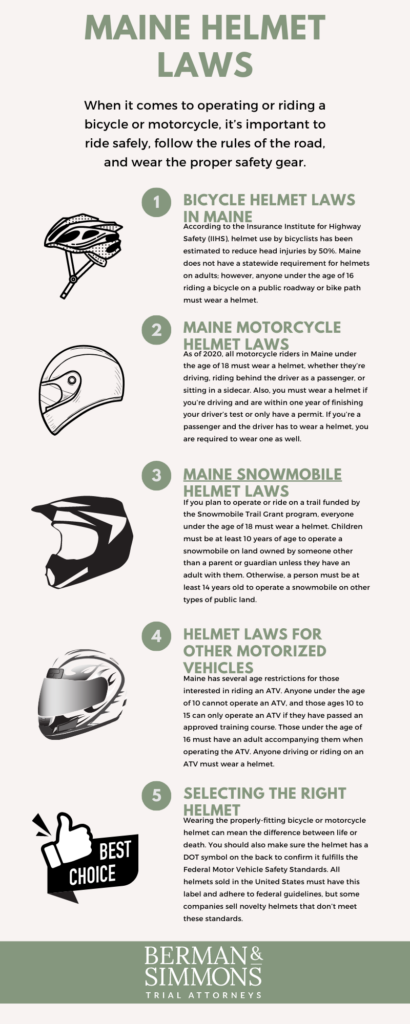When it comes to operating or riding a bicycle or motorcycle, it’s important to ride safely, follow the rules of the road, and wear the proper safety gear. In Maine, that includes wearing the right helmet, depending on several factors. Since each state has its own bicycle and motorcycle helmet laws, it’s important to know the rules in your state. Use this guide to learn more about the helmet laws in Maine.

Bicycle Helmet Laws in Maine
According to the Insurance Institute for Highway Safety (IIHS), helmet use by bicyclists has been estimated to reduce head injuries by 50%. Maine does not have a statewide requirement for helmets on adults; however, anyone under the age of 16 riding a bicycle on a public roadway or bike path must wear a helmet.
Bicyclists not wearing a helmet may receive safety information from a law enforcement officer upon their first violation. The officer might also notify the parent or guardian about where to obtain a proper helmet. With a second violation, the bicyclist can receive a traffic infraction fine of up to $25. If the bicyclist can prove that he or she purchased a helmet since the first infraction, this fine might be waived. This rule also applies if the person is riding an electric bicycle, but it excludes those riding a bicycle taxi.
Motorcycle Helmet Law History
Since 1967, state and federal governments have argued about the legality of enforcing helmet laws. The Federal Highway Safety Act required states to enforce helmet laws to qualify for certain federal safety and highway construction programs. Maine complied, but less than a decade later the federal mandate was reversed as several states lobbied Congress to stop penalizing states that fail to issue helmet laws.
As a result, several states repealed their laws. Maine reversed course in 1977 (and did what?) but just three years later added an amendment requiring all passengers under the age of 15 to wear a helmet. Today, three states do not mandate helmet usage on motorcycles (Illinois, Iowa, and New Hampshire), while 19 states require all motorcyclists to wear helmets. The other 28 states, including Maine, have only partial restrictions.
Maine Motorcycle Helmet Laws
As of 2020, all motorcycle riders in Maine under the age of 18 must wear a helmet, whether they’re driving, riding behind the driver as a passenger, or sitting in a sidecar. Also, you must wear a helmet if you’re driving and are within one year of finishing your driver’s test or only have a permit. If you’re a passenger and the driver has to wear a helmet, you are required to wear one as well.
Violators of the Maine motorcycle helmet law receive a traffic infraction and a fine of no more than $500.
Maine Snowmobile Helmet Laws
Since Maine tends to receive quite a bit of snowfall during the colder months, you might be tempted to take out a snowmobile and hit the trails. If you plan to operate or ride on a trail funded by the Snowmobile Trail Grant program, everyone under the age of 18 must wear a helmet. Children must be at least 10 years of age to operate a snowmobile on land owned by someone other than a parent or guardian unless they have an adult with them. Otherwise, a person must be at least 14 years old to operate a snowmobile on other types of public land.
Violators of the snowmobile helmet law are subject to a fine of at least $100 but no more than $500. Repeat offenders can be charged with a Class E crime, which carries a maximum penalty of up to a $1,000 fine and/or a jail sentence of up to 180 days.
Helmet Laws for Other Motorized Vehicles
Maine defines all-terrain vehicles (ATV) as off-road, motor-driven recreation vehicles that you can use on land, snow, ice, or other types of natural terrain. These vehicles can include motorcycles, three-wheel vehicles, or amphibious machines.
Maine has several age restrictions for those interested in riding an ATV. Anyone under the age of 10 cannot operate an ATV, and those ages 10 to 15 can only operate an ATV if they have passed an approved training course. Those under the age of 16 must have an adult accompanying them when operating the ATV. Anyone driving or riding on an ATV must wear a helmet.
Violators of the ATV helmet law can face the same fines as those who violate the snowmobile helmet law. They can also be charged with a Class E crime if they are repeat offenders.
Selecting the Right Helmet
Wearing the properly-fitting bicycle or motorcycle helmet can mean the difference between life or death. Everyone’s head has a different shape, and there are helmets to fit just about any head size. The most common is an intermediate oval; other options include round oval and long oval.
Use a cloth tape to measure the circumference of your head. Start just above your eyebrows and go around the thickest part of the back of your head. Use this number and cross-reference it to a helmet sizing chart. If you have a helmet that is too loose, it will move around your head. A correctly sized helmet will feel tight but not feel uncomfortable. When you shake your head, it shouldn’t move. The helmet should also feel snug around your crown and tight around your cheeks.
You should also make sure the helmet has a DOT symbol on the back to confirm it fulfills the Federal Motor Vehicle Safety Standards. All helmets sold in the United States must have this label and adhere to federal guidelines, but some companies sell novelty helmets that don’t meet these standards.
Hiring a Personal Injury Lawyer After a Motorcycle or Bicycle Accident
If you or a loved one has been in a motorcycle or bicycle accident and suffered personal injuries due to someone else’s negligence, Berman & Simmons can help. We will answer your questions, explain all of your legal options for a motorcycle or bicycle lawsuit, and provide a roadmap for what comes next.
Contact us today to schedule a free consultation.
